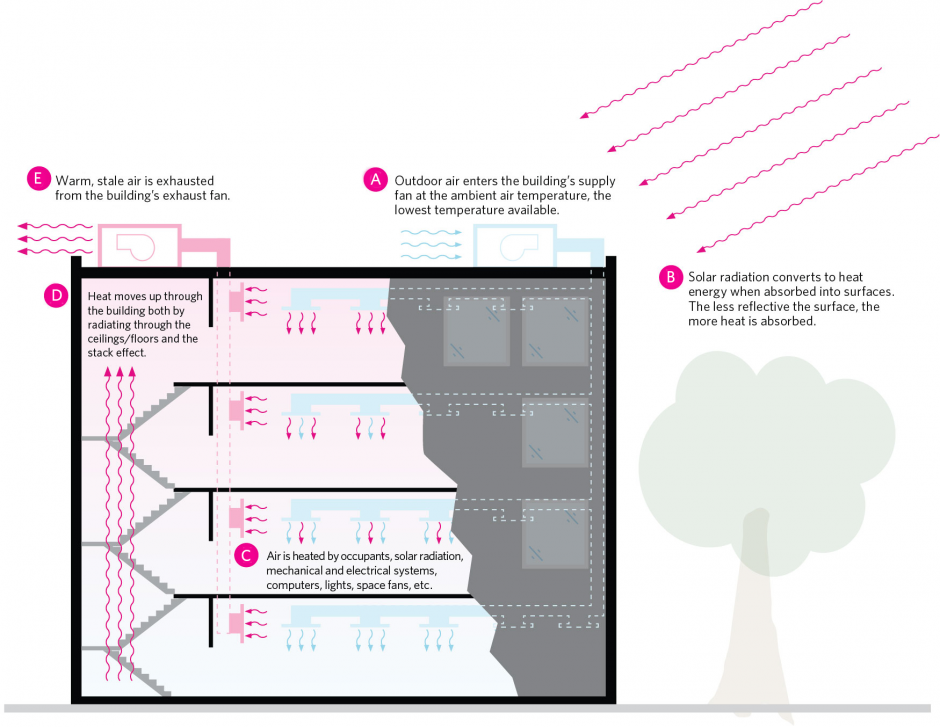Building temperature
Too hot? Too cold?
Many buildings on the UBC campus, whether by design or by age do not have air conditioning. UBC continues to upgrade and make improvements to how we deliver heating and cooling across campus.
Where possible, regulate your temperature with clothing, not by using space heaters and portable air conditioning units. If you are new to your building, ask a colleague who has worked there for a few years if the temperature you are experiencing is normal. You might be experiencing the regular hiccups associated with warmer or cooler weather, or you may have identified a more serious issue.
The UBC community is encouraged to practice these less energy-intensive methods to stay warm and cool during the warmer and cooler seasons:
- Layering up. Layering can help adjust your body temperature by putting on and removing items to maintain an even level of comfort while you work or study.
- Checking that windows are closed before leaving your building. Ensuring doors are not propped open and windows are closed and latched will help keep heated air or cool air in the room as intended.
- Check that vents in your area are free from obstructions. Make sure air can flow freely in your areas to ensure heat is evenly distributed in your space.
Should I plug in a space heater or portable air conditioning unit?
Space heaters and portable air conditioning units are not recommended, as the majority of UBC’s building electrical infrastructure are not designed to support the additional electrical load from space heaters and portable air conditioning units. If multiple space heaters and portable air conditioning units are used, this will cause circuit breaker to trip, triggering a response from UBC electricians to reset breakers accordingly.
Space heaters and portable air conditioning units will also have the effect of causing thermostats to reduce the heating or cooling even further to your room to compensate — leaving local warm or cool spots around.
If a space heater has been advised by the Facilities Manager, please consider a low power (200 Watts max.) under-desk heater, heated floor mat, or electric blanket. Portable fans that only blow air are acceptable as these devices consume minimal amount of electricity.
Before you plug in a space heater or portable air conditioning unit—contact the Service Centre (604-822-2173) or your Facilities Manager and discuss the best way to manage the temperature in your space. Our teams will work with you to identify the issue and help find a solution.
Understanding passive cooling at UBC
Many buildings on the UBC campus, whether by design or by age use passive cooling through the air circulation system.
When the weather gets very warm, the ability of passive cooling to keep up with the heat in the buildings can be stressed, and you may notice some discomfort. To understand how passive cooling typically works, take a look at the diagram below:

- Outdoor air enters the building’s supply fan at the ambient air temperature, the lowest temperature available.
- Solar radiation converts to heat energy when absorbed into surfaces. The less reflective the surface, the more heat is absorbed.
- Air is heated by occupants, solar radiation, mechanical and electrical systems, computers, lights, space fans, etc.
- Heat moves up through the building both by radiating through the ceilings/floors and the stack effect.
- Warm, stale air is exhausted from the building’s exhaust fan.
Understanding heating at UBC
The buildings at UBC have been built, updated, retrofitted, and maintained on over a century. Because of this, it is very difficult to talk about a “typical building” and what can be considered ordinary. Each building has their own unique heating systems.
For many core UBC buildings, our Energy & Water Services’ department operates a district energy system (DES) to distribute heat. In these DES systems, heat is generated at a central site (the Campus Energy Centre and Bioenergy Research Demonstration Facility) and then distributed through a system of pipes under campus to over 100 buildings, where devices called heat exchangers transfer the heat from the DES into separate heating or hot water systems within the building. The building’s heating hot water is then circulated through the building to radiators and heating coils for space heating or through separate domestic hot water systems to taps.
Some buildings are not connected to the DES system (e.g., for small buildings or those far away from the DES system) – in these cases a separate natural gas or electric system is used within the building to support heating and domestic hot water.
Contact the Service Centre / Facilities Manager
Our Facilities Managers will work with your Building Administrator to ensure that nothing gets overlooked. Facilities Managers take a personal interest in managing issues directly with Senior Leadership and our Facilities teams. Learn more about your building or find your Facilities Manager.
When you contact the Service Centre, be prepared to answer the following questions:
- What is your exact location (building and room number)
- Are you feeling too hot or too cold?
- How large is the affected area?
- What type of space is affected?
- Are there any temperature sensitive research, equipment or specimens in this area?
- How long has this been going on?
- If equipped, what is the temperature at the nearest thermostat?
Additional information
Did you find what you were looking for?
Thanks for your response! If you'd like to share further feedback, please take our survey.
Didn’t find what you were looking for? We’d like to hear from you! Share your thoughts by taking our survey.